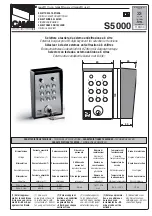
144
Global mode
Mode Preferences: Style
Expert
When in Split mode, play two or more notes for a
chord to be recognized. When in Full Keyboard
mode, play at least three notes.
If you play just one note, a unison will be played.
If you play a fifth, a “root+5th” chord will be
played.
With this mode, you can play rootless and slashed
chords, often used in jazz, fusion, modern pop
and light music. This type of chord recognition is
very useful to play piano chords typical of jazz
piano players. You don’t always need to play the
root note, doubling the note already played by the
bass track.
Velocity Control
Set this parameter to trigger one of the following functions sim-
ply by playing louder with your left hand. When playing with a
velocity value higher than the value set by the “Velocity Control
Value” parameter (see page 144), the selected function will be
activated.
This function only works when the SPLIT LED is turned on.
Off
The function is turned off.
Break
When playing with a velocity higher than the
trigger value on the Lower track, the Break is
automatically triggered.
Start/Stop
You can start or stop the Style by playing harder
on the keyboard.
Bass Inversion When playing with a velocity higher than the
trigger value, the Bass Inversion function will be
activated or deactivated.
Memory
When playing with a velocity higher than the
trigger value, the Memory function will be acti-
vated or deactivated.
Velocity Control Value
Use this parameter to set a velocity threshold over which to auto-
matically trigger the Style Start/Stop or select one of the other
functions (see “Velocity Control” above).
Scale Mode
This parameter defines which tracks are affected by the selected
alternative scale (see “Scales” on page 242).
Keyboard Tracks
The scale will affect all Keyboard tracks.
Upper Tracks The scale will only affect Upper 1-3 Keyboard
tracks.
All Tracks
The scale will affect all tracks (Keyboard, Style,
Pads).
Memory Mode
This parameter sets the way the MEMORY button works.
Chord
When the MEMORY LED is on, recognized
chords are kept in memory even when raising
your hand from the keyboard. When the LED is
off, chords are reset when raising your hand.
Chord + Lower
When the MEMORY LED is on, recognized
chords are kept in memory, and the Lower sound
is held until the next note or chord is played.
When the LED is off, both the chord (and there-
fore the accompaniment) and Lower sound are
cut when raising the hand from the keyboard.
Fixed Arr. + Lower
When the MEMORY LED is on, recognized
chords are kept in memory, and the Lower sound
is held until the next note or chord is played.
When the MEMORY LED is off, the Lower sound
is cut when raising the hand from the keyboard;
on the contrary, the chord is kept in memory (so
that the accompaniment can continue to play).
Bass & Lower Backing
With this function, you can play a simple accompaniment with
your left hand. For this to work, the SPLIT LED must be turned
on, and the Style must not be running. By default, this function
is turned on.
On
When the Style is not running, and you play a
chord with your left hand, the chord is played by
the Lower Sound (even if it is muted), while the
chord root is played by the Bass Sound. When
you start the Style, the normal behavior is
restored.
When the Bass & Lower Backing
function is active, the Backing
icon appears in the Lower track Sound’s area.
Off
No Bass Sound is added when the Style is not
running. The Lower track can be heard only if it
is not muted.
Style Tracks Global Volume
In Style Play mode, the volume of the grouped Style tracks is a
global offset of the values memorized in the Style. When you
choose a different Style, this offset will not change, and the aver-
age volume of the Style tracks remains the same.
These controls allows you to globally set the balance between the
Drum/Percussion, Bass and Accompaniment tracks. For exam-
ple, if you prefer Drums and Bass to be prominent to make them
have more ‘punch’, you can lower the grouped Accompaniment
tracks.
Changes are not memorized to a Performance or to the current
Style Settings. Instead, they are memorized as a global parame-
ter.
0…127
Volume level.
Summary of Contents for PA 600 QT
Page 1: ...Reference Guide ENGLISH OS Ver 1 0 1 E ...
Page 2: ......
Page 8: ...4 Table of Contents ...
Page 9: ......
Page 196: ...192 MIDI Playing another instrument with Pa600 ...
Page 197: ......
Page 327: ......
















































